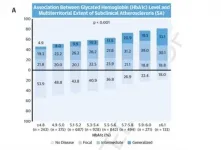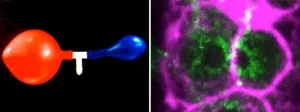(Press-News.org) RNA sequencing is a powerful technology for studying cells and diseases. In particular, single-cell RNA sequencing helps uncover the heterogeneity and diversity of our body. This is the central technology of the "Human Cell Atlas" in its quest to map all human cells. However, single-cell RNA sequencing reaches its limits in very large projects, as it is time-consuming and very expensive. To address these challenges, scientists from the research group of Christoph Bock, principal investigator at the CeMM Research Center for Molecular Medicine of the Austrian Academy of Sciences and professor at the Medical University of Vienna, developed a new method for sequencing huge numbers of single cells in an efficient manner. The study has now been published in Nature Methods.
Molecular analysis of single cells provides an important basis for precision medicine. Five years ago, scientists around the world came together to pursue the "Human Cell Atlas" project, with the aim of cataloging all cells in the human body. These data have helped, for example, to identify those cell types that the coronavirus can infect particularly well. To accelerate and improve the creation of such cell catalogs, Paul Datlinger and André F. Rendeiro from Christoph Bock's research group at CeMM developed a new method that enables single-cell RNA sequencing in a very large number of individual cells at the same time.
This method, which is called "scifi-RNA-seq" (for: "single-cell combinatorial fluidic indexing"), marks the RNA of many cells with specific barcodes, before the cells are loaded on a microfluidic chip and their RNA is prepared for single-cell sequencing. These additional barcodes overcome an important problem with existing methods for single-cell sequencing, where single cells are packed into tiny emulsion droplets and assigned cell-specific barcodes. When several cells land in the same droplet, they receive the same barcode and can no longer be distinguished. Therefore, the single cell suspension is loaded onto the microfluidic chip at low concentrations, which means that most of the emulsion droplets remain empty, and the reagents are used very inefficiently.
In the scifi-RNA-seq method, the cells are marked in advance with an additional barcode. As a result, the emulsion droplets can be loaded with many cells at the same time, while it is still possible to analyze individual cells. Study author Paul Datlinger explains: "On the popular 10x Genomics system, we use this method to measure 15 times more individual cells. The additional barcode also allows the user to mark and combine thousands of samples in advance, and to process those samples together in a single microfluidic analysis. As part of our study, we performed a CRISPR screen with single-cell RNA sequencing readout in human T cells. In the future, our method may, among other things, help to improve immunotherapies for the treatment of cancer."
An efficient high-throughput method with a wide range of applications
Projects that need to apply single-cell RNA sequencing to very large numbers of cells or very many samples will particularly benefit from the new method. Project leader Christoph Bock explains: "scifi-RNA-seq enables efficient RNA sequencing for millions of individual cells, which facilitates the characterization of complex tissues, organs, and entire organisms. Moreover, in biomedicine it is often useful to analyze many single cells, for example to discover rare stem cells in tumors or cancer cells in the blood. Finally, scifi-RNA-seq will contribute to the trend that drug screens and CRISPR screens are increasingly combined with high-resolution single-cell sequencing readouts. "
INFORMATION:
The study "Ultra-high-throughput single-cell RNA sequencing and perturbation screening with combinatorial fluidic indexing" was published in Nature Methods on 31 Mai 2021 (online ahead of print), DOI: 10.1038/s41592-021-01153-z
Authors: Paul Datlinger, André F. Rendeiro, Thorina Boenke, Martin Senekowitsch, Thomas Krausgruber, Daniele Barreca, Christoph Bock
Funding: This work was conducted in the context of two Austrian Science Fund (FWF) Special Research Program grants (FWF SFB F6102; FWF SFB F7001). Thomas Krausgruber was supported by a Lise Meitner fellowship from the Austrian Science Fund (FWF M2403). Christoph Bock is supported by an ERC Starting Grant (European Union's Horizon 2020 research and innovation program, grant agreement no. 679146).
Christoph Bock is a principal investigator at the CeMM Research Center for Molecular Medicine of the Austrian Academy of Sciences in Vienna, where he has led a research group since 2012, and a professor of medical informatics at the Medical University of Vienna since 2021. Before Christoph Bock joined CeMM, he was a postdoc at the Broad Institute of MIT and Harvard and at Harvard University (2008-2011), and a PhD student at the Max Planck Institute for Informatics (2004-2008). He is also scientific coordinator of the Biomedical Sequencing Facility of CeMM and MedUni Vienna, "key researcher" at the Ludwig Boltzmann Institute for Rare and Undiagnosed Diseases (LBI-RUD), fellow of the European Lab for Learning and Intelligent Systems (ELLIS), and elected member of the Young Academy of the Austrian Academy of Sciences. He has received important research awards, including the Otto Hahn Medal of the Max Planck Society (2009), an ERC Starting Grant (2016-2021), an ERC Consolidator Grant (2021-2026), and the Overton Prize of the International Society for Computational Biology (2017). For 2019 and 2020 he was included in the global list of "Highly Cited Researchers" by Clarivate Analytics (ISI Web of Science).
The mission of CeMM Research Center for Molecular Medicine of the Austrian Academy of Sciences is to achieve maximum scientific innovation in molecular medicine to improve healthcare. At CeMM, an international and creative team of scientists and medical doctors pursues free-minded basic life science research in a large and vibrant hospital environment of outstanding medical tradition and practice. CeMM's research is based on post-genomic technologies and focuses on societally important diseases, such as immune disorders and infections, cancer and metabolic disorders. CeMM operates in a unique mode of super-cooperation, connecting biology with medicine, experiments with computation, discovery with translation, and science with society and the arts. The goal of CeMM is to pioneer the science that nurtures the precise, personalized, predictive and preventive medicine of the future. CeMM trains a modern blend of biomedical scientists and is located at the campus of the General Hospital and the Medical University of Vienna. http://www.cemm.at
Medical University of Vienna (MedUni Vienna) is one of the most traditional medical education and research facilities in Europe. With almost 8,000 students, it is currently the largest medical training center in the German-speaking countries. With 5,500 employees, 30 departments and two clinical institutes, 12 medical theory centers and numerous highly specialized laboratories, it is also one of Europe's leading research establishments in the biomedical sector. http://www.meduniwien.ac.at
Researchers at the Biomedicine Institute of Seville (IBiS) have discovered a new mechanism of Alzheimer's disease that disorganises the blood vessels around amyloid plaques, one of the characteristic features of the disease. The study, published in the international journal Nature Communications, was led by the laboratory of Dr. Alberto Pascual, from the Neuronal Maintenance Mechanisms Group at IBiS and was chiefly carried out by María Isabel Álvarez Vergara and Alicia E. Rosales-Nieves.
Relevance of the finding
Alzheimer's disease is the leading cause of dementia worldwide. In Spain, its incidence is increasing dramatically as the population ages and yet, unfortunately, the origin of the disease is still unknown.
The mechanism put forward ...
New research has found that adolescents with higher levels of an omega-3 fatty acid in their blood were less likely to develop psychotic disorder in early adulthood, suggesting that it may have a potential preventative effect of reducing the risk of psychosis.
The study, led by researchers from RCSI University of Medicine and Health Sciences, is published in END ...
The routine use of the glycosylated hemoglobin test to track blood sugar levels in the general population can identify individuals with more advanced atherosclerotic disease. Currently used in the diagnosis and management of diabetes, glycosylated hemoglobin can provide a useful estimate of atherosclerotic disease, and therefore of cardiovascular risk, in individuals without diabetes with or without possible prediabetes. This is the main finding of a study carried out by scientists at the Centro Nacional de Investigaciones Cardiovasculares (CNIC).
The advance heralded by the CNIC study is the use of this blood-sugar measure in apparently healthy middle-aged ...
Skoltech researchers used the resources of the university's Zhores supercomputer to study a new method of generating gamma-ray combs for nuclear and X-ray photonics and spectroscopy of new materials. The paper was published in the journal Physical Review Letters.
A gamma-ray comb is a series of short bursts that, when plotted as intensity versus frequency, look like sharp and equally spaced teeth of a comb. Generating these combs at high brightness in the gamma-ray domain has been challenging because of something called ponderomotive spectral broadening - an effect that destroys the monochromaticity that allows gamma-ray sources to be used in nuclear spectroscopy, medicine, and other applications.
Sergey ...
The intriguing chemistry and biology of sulfur?containing natural products from marine microorganisms (1987-2020)
https://doi.org/10.1007/s42995-021-00101-2
Announcing a new publication for Marine Life Science & Technology journal. In this review article the authors Yang Hai, Mei?Yan Wei, Chang?Yun Wang, Yu?Cheng Gu and Chang?Lun Shao from Ocean University of China, Qingdao, China and Syngenta Jealott's Hill International Research Centre, Berkshire, UK consider the chemistry and biology of sulfur?containing natural products from marine microorganisms.
Natural products derived ...
The National Institute of Polar Research (NIPR) publishes Polar Science, a peer-reviewed quarterly journal dealing with polar science in collaboration with the Elsevier B. V.. The most recent issue (Vol. 27 published in March 2021) was a special issue entitled "Arctic Challenge for Sustainability Project (ArCS)," which featured the former national (nation-wide) Arctic research project in Japan. The full text of this issue is freely accessible worldwide for a limited time until 10 September 2021.
The Arctic Research Project "Arctic Challenge for Sustainability (ArCS)" was carried out from September 2015 to March 2020 as a national flagship project funded by the Ministry of Education, Culture, Sports, ...
In past studies, researchers have found that C. elegans gonads generate more germ cells than needed and that only half of them grow to become oocytes, while the rest shrinks and die by physiological apoptosis, a programmed cell death that occurs in multicellular organisms. Now, scientists from the Biotechnology Center of the TU Dresden (BIOTEC), the Max Planck Institute of Molecular Cell Biology and Genetics (MPI-CBG), the Cluster of Excellence Physics of Life (PoL) at the TU Dresden, the Max Planck Institute for the Physics of Complex Systems (MPI-PKS), the Flatiron Institute, NY, and the University of California, Berkeley, found evidence to answer the question of what triggers this cell fate decision between life and death in the germline.
Prior studies ...
Researchers from Trinity College Dublin have developed a novel set of tools for designing vitamin D clinical trials that capture large seasonal and population-wide differences in vitamin D status, typically seen in individuals. Their study published in the journal Scientific Reports (today, Monday 31st May 2021) provides a framework for clinical trials to establish whether vitamin D supplementation is effective against a given disease.
The study also reveals that many trials which failed to find any association between vitamin D and disease prevention may have been underpowered or conducted without enough subjects to detect a benefit of vitamin D.
You can read the full journal paper here: https://go.nature.com/3uERjgO
The ...
YouTube is a treasure trove of virtual reality fails: users tripping, colliding into walls and smacking inanimate and animate objects. By investigating these "VR Fails" on YouTube, researchers at the University of Copenhagen have sought to learn more about when and why things go sideways for users and how to improve VR design and experiences so as to avoid accidents.
Millions of YouTube viewers have enjoyed hearty laughs watching others getting hurt using virtual reality - people wearing VR headsets, falling, screaming, crashing into walls and TV sets, or knocking spectators to the floor. Some of us have even been that failing someone. Now, videos of virtual reality mishaps, called "VR Fails", ...
Redox-flow batteries store electrical energy in chemical compounds that are dissolved in an electrolyte. They are a particularly promising alternative to lithium-ion batteries as stationary energy storage. A team headed by Prof. Dr. Ingo Krossing from the Institute of Inorganic and Analytical Chemistry at the University of Freiburg has succeeded in developing a non-aqueous All-Manganese Flow battery (All-MFB) that uses sustainable manganese as its active material and has a long cycle life. The researchers present the results of their work in the latest edition of Advanced Energy Materials.
Active materials are ...




